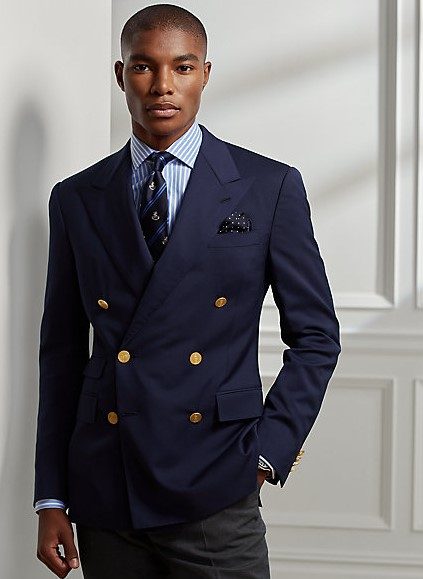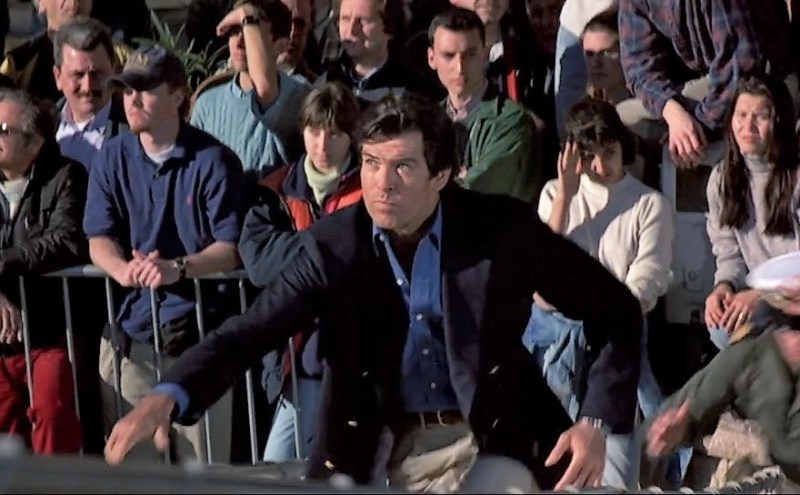Your tailored wardrobe can be tricky. Once you figure out which suits to buy and how many suits you need, you then have to focus on other options, like how to style a sports coat or blazer.
Finding the perfect blazer is harder than it looks. The real key to this in-between essential? Fit. Let’s break down exactly how a blazer should fit and why it matters. Keep reading to answer the burning question, “How should a blazer fit?”
What is a blazer?

The blazer is the middle child of the tailored jacket world and often gets overlooked. While the suit coat is the most formal of the tailored wardrobe (save for the highly specialized tuxedo jacket), the sport coat is the least formal. The blazer is the middle ground and is often mistaken and used interchangeably with a sport coat.
The most traditional blazer is the navy blue double-breasted version with six buttons. This staple of men’s tailored garments was originally designed for the British Royal Navy and has since become a representation of nautical culture.
The fit of these jackets is slightly different from that of a suit. But besides the fit, what sets these jackets apart from their contemporaries is the contrasted gold or pewter buttons instead of the standard buttons you will find on your suit coat. You would typically not wear pants of a similar color, opting for muted grays and tans or going ultimately in the opposite direction and donning much brighter colors.
Why do the sleeves have buttons?

Before we discuss how a men’s blazer should fit, let’s answer one burning question: Why do most blazers have buttons on the sleeves that serve no apparent purpose?
Well, the origin of sleeve buttons is a slightly gross story. According to the legend, the buttons on the sleeves are part of an effort to keep military uniforms clean. Uniform jackets had buttons on the sleeves to stop soldiers from wiping their noses or mouths with their sleeves, which would make the troops look shabby.
The buttons were designed to make it hard (or even painful if the buttons were metal) to use the sleeve as a handkerchief. So that’s a fun fact you can use as an icebreaker at your next social event.
Elements of style

First, keep in mind that a good blazer can practically be a stand-in for a suit on these more casual, comfortable days.
Need a more formal look?
Wear it with a pair of dark, solid trousers in a complementary hue, a classic white dress shirt, and a stylish, high-quality tie.
Headed to a new client meeting?
Try white jeans or brighter five-pocket pants and a patterned button-up shirt.
Going to a romantic dinner?
Nobody will complain if dark jeans and a V-neck T-shirt or cashmere sweater complete the outfit. Look for a neutral color with some surface interest: A subtle plaid, an updated herringbone, or a tonal stripe. A classic solid navy, khaki, olive, or white is great for summer.
Our best advice? Put yourself into an expert’s hands. Head to a store where the sales staff’s style impresses you. Let them guide you in fit and fashion, but show them that you know what you’re doing, too, and that you know what you want.
Added bonus: A good clothing store for men will also keep a good tailor on hand, so if you’re not built like a flawless Adonis, you can always have a few adjustments made for the best possible fit. While those salespeople and tailors will know full well how a blazer is supposed to fit, it’s always good to have your own understanding, and therefore, we have put together this guide to help you understand your blazer before you buy it.
Blazer terminology and fit requirements

Generally speaking, we’re still in a slim-fit era. Blazers aren’t the sausage casings they once were, but they are pretty body-conscious.
A modern blazer should have a somewhat relaxed, less structured feel. Fabrics should include some stretch, so the jacket moves and feels more like a really fancy sweater and less like a suit coat. Think about their origins. The last thing you want when you are on a ship on the high seas is to be unable to move.
- Collar: Rest smoothly across the back
- Back: Fall smoothly down your back, without any pulling, creasing, or wrinkling
- Lapel: Fall flat and rest across the chest
- Chest: There should be about three inches between your body and the top button when you sit down
- Waist: Vents in the back lie flat
- Shoulders:The shoulders line up with the top of your arms
- Sleeves: The sleeve lands just above the wrist bone
- Armholes: Allows you enough room to move comfortably
- Length: A bit shorter than your seat
Collar and back
The jacket collar is at the top of the lapel. It’s the part that wraps around the back of your neck. Be sure that the collar isn’t so high that it obscures the collar of your shirt, nor should it gape away from your neck. It should rest smoothly across the back.
The back of the jacket is, of course, the simple panel of fabric that drops from the shoulders down your back to your butt. The back may end in a slit in the middle called a center vent; opened on the left and right, a side vent; or have no opening at all, forming a tube around your body where it’s joined to the front. The fabric should fall smoothly down your back, without any pulling, creasing, or wrinkling.
Lapel
The lapel joins the collar, folding open from the inside to form a V-shape. Those trendy Gucci lapels are so wide they practically come out to your armpits. Some of the latest looks from Zegna have no lapels at all.
We like a simple notch lapel, forming a sideways “V,” where the lapel attaches to the collar (also called the gorge). Peak lapels are a great look but aren’t normally associated with a classic blazer. A modern gorge rides pretty high on the lapel, probably high enough to rest on the top of your pectorals, pointing to your shoulders.
Be sure that the lapels fall flat and rest across the chest. You should easily be able to reach into the jacket under the lapel to stash things in the inside chest pockets (but don’t get carried away; too much and your blazer will look like a busy chipmunk’s cheeks).
Chest and waist
The chest is the front part of the jacket, falling from the shoulder over your chest and down toward your pelvis. The button and buttonhole should rest just above the belly button. We still like a two-button blazer the best.
Although you should always button your blazer when standing and unbutton it when seated, for fit purposes, there should be a little bit of room — say three inches or so — between your body and the top button when you sit down.
Check that the body of the jacket doesn’t cling to you or crease in any weird ways, especially when you move: You shouldn’t need to complete a CrossFit in a blazer, but you also shouldn’t feel like you’ll tear something if you reach for a book on a shelf or bend over to pet the dog. There should be a bit of a nip at the waist, forming what photographers call a light leak between the body of the jacket and the sleeves.
Do those vents in the back lie flat, or are they gaping open over your ass, or straining? If so, the jacket is too tight. If you never miss a leg day and your booty is on point, beware: You may have trouble finding a blazer that doesn’t gape or hang over your butt like a parade banner. Again, consult a good salesperson.
Shoulders

A simple, natural shoulder is best, but sometimes nature has other ideas. You may not have Vin Diesel’s shoulders, or you might find that one shoulder is a little lower than another.
A little padding can make the wearer look a little bolder and stronger without making him look like he’s suited up for the Super Bowl. Be sure the shoulders line up with the top of your arms and aren’t too wide or too tight. They should look natural and lie flat.
Sleeves
The classic ideal in a blazer was that it should allow about 1/2-inch of your shirt to show. Of course, that’s assuming you’re even wearing a white dress shirt. We like to compromise by saying the sleeve should land just above the wrist bone.
That should allow enough room for most shirts and give you clearance for your favorite watch. (Again, check with a tailor here. One arm is often a bit longer than the other, so an alteration can make everything look symmetrical.) If you’re a regular at the gym, make sure you’re allowing yourself enough room through the upper arm, too.
Armhole
It may seem too simple: Yeah, this is the part of the jacket that you put your arm through. Yet a higher armhole, common during those super skinny days of the aughts, can really limit a range of motion. Too low, and the blazer will look 1980s vintage. Make sure that the armhole allows you enough room to move comfortably.
Length
It used to be said that jackets should be long enough to cover your seat. Blazers have often been just a bit shorter than that, with a sportier fit than suit coats. Although it still shouldn’t be any higher than your butt, grazing the top of your cheeks or landing mid-peach is more modern.
Replacing the buttons on a blazer

No matter how careful you are or how well you take care of a garment, buttons fall off or get lost. It’s always more desirable to keep the buttons designed to adorn the blazer when you buy it, but that isn’t always possible if you lose a button and don’t hold on to the extras provided when you bought it. However, if you do need to replace the buttons on your blazer, there are a few things to keep in mind.
First off, it is always better to take it to a tailor. It may seem like a small thing to replace a button, but if you sew it back on even a centimeter off, it can be noticeable. Another benefit of taking it to a tailor (especially if it’s an in-house tailor where you bought the blazer) is that they may have a single button to match the others.
Second, stick to brass or pewter buttons. If you have to buy a whole new set of buttons, you might as well get what you like. Gold is the most classic look and will keep you looking as elegant as possible. But pewter will give you a more updated and stylish look. With the added bonus of matching your silver bracelet watches or silver belt buckles.
There you are, a complete rundown of all the different focus areas for your next blazer. Take this information with you when you go shopping for a new blazer, and you will be able to keep up with the tailor while they fit it to your body perfectly.
Just remember that one of the tips that all men should follow is to get to know a tailor. This is one of those times when being chummy with someone who can work a ruler and a needle will come in handy.




